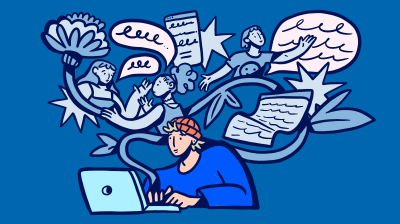How you regulate your emotions
Emotional regulation tools and strategies to help you manage difficult or intense emotions and support your mental health.

Emotions are one of the central building blocks of your internal experience. They help shape how you understand yourself and the world around you. Emotions can also have an impact on your thoughts and your actions. People experience a wide range of emotions every day, and sometimes, emotions can become intense and difficult to deal with. This is why it’s important to have healthy ways of feeling and processing intense emotions, so you can cope with them, and live the life you want to live.
The ability to influence your emotional state is called emotional regulation. If you want to build your emotion regulation skills, you can start by understanding what emotions are and where they come from.
What are emotions?
Most people experience many emotions every day, but it can be tricky to describe exactly what emotions are. Emotions are internal experiences that are triggered by external or internal events. An emotional reaction is stimulated when something in your environment gets your attention because it’s relevant to your needs or goals. For example, you may feel happy or proud when you get a compliment from a friend.
Emotions are designed to help you stay safe and get the things you need to foster your wellbeing. It might not always feel like it, but even difficult or painful emotions have value and play an important role in survival.
How many emotions are there?
People are capable of experiencing a complex system of emotions. Many psychologists have made lists of all the different emotions people can feel. Some of these contain thousands of entries. These longer lists can be overwhelming, so many prefer to focus on 6 primary categories which emotions can be divided into:
- Happiness
- Sadness
- Anger
- Surprise
- Fear
- Disgust
What are the different components of an emotion?
There’s more to emotions than you might think. Experiencing an emotion is not just a feeling, it actually sparks a series of interlinked changes within you. Becoming more aware of the different aspects of your emotions can help you to understand and manage them more effectively.
- Feeling: This is the feeling you experience, like happy, sad, angry, etc. It’s the most obvious part of an emotion. People experience emotions differently, so this feeling can be unique to you. For example, if you have a big speech coming up at work or at school, you might feel nervous.
- Motivation: Emotions come with an urge to take action. The action will be different depending on the person, the situation, and the emotion they are experiencing. For example, feeling nervous before giving a big speech might make you want to run away and not give the speech.
- Meaning-making: When someone experiences an emotion, they often use it to help learn more about whatever triggered that emotion. For example, Feeling nervous before the big speech can make you feel like you’re not good at giving speeches, or might make you think that the speech isn’t going to go well.
- Communication: Emotions trigger changes in our bodies that help us to communicate how we’re feeling to other people. Feeling nervous might cause you to fidget or it might make your voice shake. All of these reactions help show the people around you how you’re feeling so they can respond in a way that supports your needs.
- Physical sensation: Emotions also trigger chemical reactions within the body, some of which come with physical sensations. For example, feeling nervous can make your heart rate increase. You might feel shaky or have a tight feeling in your chest.
As discussed above, emotions often act as internal signals that help us identify dangers or rewards. We can also use emotions as information to help make informed decisions. The problem is that the meaning we attach to our emotions and the decisions we make based solely on these emotions might not always give us the full picture or lead us to the best choices.
Take fear for example. If you found yourself in a situation where an aggressive animal is nearby, this could trigger a fear response, and that feeling of fear could cause you to run away. In this situation taking action based on the fear response is a good decision and helps keep you safe. However, if instead you were feeling scared because you had an important exam tomorrow, your fear response might make you want to avoid the situation by not studying. In this case, following your fear response would actually make the situation worse.
This is why it’s so important to be able to regulate strong emotions. It helps you decide when to act on an emotional trigger and when to hold back, allowing you to respond in a way that supports your mental health.
What is emotional regulation?
Emotional regulation is the process of influencing your emotional state, how you express your emotions, and how you respond to your emotions. You engage in emotional regulation all the time, sometimes consciously and sometimes unconsciously. People use many different mental and behavioural techniques to regulate their emotions. Some of these techniques can be used before an emotion emerges, and others can be used after the emotion has begun.
Often, the goal of emotional regulation is to lower the intensity of emotions to make them easier to tolerate. As an individual gradually develops the ability to tolerate strong emotions without immediately trying to avoid or act on them, they may notice that the intensity of the strong emotion gradually reduces with time. For example, someone who is experiencing intense anger might focus on their breathing to distract themselves and ease their anger. The goal of emotional regulation is not to ignore your emotions or to feel your emotions less frequently, but to be able to feel and express them in ways that are safe for you and those around you.
Tips for regulating your emotions
Everyone has their own habitual ways of regulating emotions that they developed as they grew up, but that doesn’t mean your methods can’t be changed. The great thing about emotional regulation is that it’s a skill that can be learned. You can develop new and effective ways for managing your emotions at any age. Here are some methods you can try if you want to build your emotional regulation skills.
Pay attention to the whole emotion
Emotion regulation begins with building an awareness of your emotions. Taking time to notice what emotions you’re feeling in a given situation is a good place to start. Here are some questions you can ask yourself to explore the different aspects of the emotions you’re experiencing.
- How am I feeling?
- What is this emotion motivating me to do?
- How am I expressing this emotion?
- What physical sensations am I feeling in my body?
Being able to recognise what emotion you’re experiencing and how it’s affecting you makes it easier to decide what to do next.
If you’re experiencing really intense emotions, it can be difficult to ask yourself these questions in the moment. This is because strong feelings can be overwhelming and make it difficult to think clearly. In those cases, you can still ask yourself these questions after the emotion has passed. There are also steps you can take to create some space in the moment and help you get a new perspective on how you’re feeling. You can learn more about delaying your reactions to your emotions below.
Label your emotions
Once you have tuned in to what you’re feeling, labelling the emotions you’re experiencing is the next step. Having an emotional vocabulary is an important tool for regulating emotions. An emotional vocabulary is a collection of words that you can use to identify and describe your emotions.
Emotions don’t always pop up one by one. It’s common to experience a number of different emotions all at once. Sometimes one emotion can hide underneath another. For example, on the surface, you may be experiencing anger, but that anger could be driven by fear. Having a strong emotional vocabulary helps to untangle different emotions, making it easier to understand and work with them. It also makes it easier to express yourself and share your emotions with other people.
Identify your triggers
As you become more aware of your emotions, it’s important to explore where your emotions are coming from. There is a broad range of things that can cause an emotional response. Emotions often emerge in response to your environment or the situation you’re in. For example, seeing a dog in the street might make you feel happy.
The type of emotion you will experience in a given situation is shaped, in part, by your past experiences and how you interpret the situation you’re in. Two people in the same situation could experience very different emotional responses. For example, if you and your friend see a dog in the street, you might feel happy if you have had positive experiences with dogs growing up, but your friend might feel afraid if they were attacked by a dog in the past. This happened because your past experience caused you to interpret the situation differently.
Past experiences influence the thoughts you have in a given situation. These thoughts can happen automatically and you might not even realise you’re thinking them, but they affect which emotions you will experience. Here are some types of thoughts that can have a big impact on emotions.
- What happened was unexpected
- What happened is going to make it harder for me to get what I need
- I can’t control what happens next
- I fear I won’t be able to cope with what happens next
- I think what happened was my fault
If you experience an intense emotion, getting to the bottom of where it came from by exploring the thoughts you’re having about the situation you’re in can make it easier to understand what you’re feeling and to communicate your feelings to others.
Delay your response time
When you experience an intense emotion, the urge to act on that emotion can be intense too. This can cause you to act without thinking. Having lots of intense emotions can be distressing and make you feel out of control. Creating some space and allowing yourself to feel the emotion without immediately reacting to it can help you feel more in control of what happens next.
This can be achieved in different ways. If possible, try creating some physical distance between you and the situation. If you can’t leave the situation, creating some psychological distance by distracting yourself with some deep breathing or another mindfulness technique can be useful. Strong emotions can override other important motivations, values and goals. Taking these steps can allow the initial surge of emotions to settle down before you react, allowing you to zoom out and keep your other goals and values in mind.
When you’re able to think more clearly, you can make better decisions. Delaying your response time can be difficult and takes practice, so don’t be surprised if you struggle with it as you adjust.
Practise self-compassion
If you are starting your emotional regulation journey, it’s important to be kind and patient with yourself. The goal of emotion regulation is not to suppress or avoid emotions, but to reframe what they mean to you and take a look at how you respond to them. To achieve this, you must first observe your emotions without judgement.
If you’ve ever felt guilty or upset for feeling a certain way, you’re not alone. Emotions that you experience in response to other emotions are called meta-emotions. Meta-emotions are how someone might think and feel about the feelings they are having. For example, you might feel anger when you drop your phone, and then get annoyed at yourself for losing your temper over something small. Some people have more of these meta-emotions than others.
There are a number of things that might cause someone to get nervous or upset for having negative emotions. For example, if you grew up in an environment where the people around you didn’t show a lot of emotion, or if you were often criticised for showing emotion, you might find you don’t feel as comfortable expressing your full range of feelings.
Allowing yourself to feel any or all emotions without judgement isn’t easy to do. It helps to remember that all emotions, even difficult ones, are an essential part of life, and even though feeling certain emotions can be distressing, they can also act as important signals. You never have to feel guilty for feeling an emotion. Remind yourself that that emotion doesn’t define you. You can’t choose what to feel, but you can choose what you do with those feelings.
Working with a therapist
Building emotional awareness and learning skills to regulate your emotions more effectively can be difficult to do alone. Many people find that receiving mental health treatment is a good time to explore their emotions and learn new ways to manage them. It’s easier to reflect on past experiences and the associated emotions when you’re in a safe and relaxing environment. This is why working with a therapist can make the process easier. Engaging with a trained therapist can help you see your emotions more objectively. They can also spot emotional patterns and triggers that you may not be able to see yourself.
Psychotherapists who practice evidence-based therapies like Cognitive behavioural therapy (CBT) are trained to help their clients build emotional awareness and regulation in structured ways. Through CBT, you will develop strategies to help you build self-awareness and identify triggers, create helpful routines, and manage compulsive thoughts and unhelpful behaviours.
If you find it difficult to cope with intense emotions or if your emotions often make life more challenging for you, a therapist can help you process and manage these feelings in safe ways that are appropriate for your needs and situation. There are many different evidence-based talk therapies, and what works well for someone else might not be the best approach for you. If you are thinking about starting therapy to help with your thinking patterns, explore the different types of therapy that are available to you and don’t be discouraged if your first experience isn’t the best fit. Therapy is a very personal thing, and it can take time to find the right therapy for you.
Feeling overwhelmed and want to talk to someone?
- Get anonymous support 24/7 with our text message support service
- Connect with a trained volunteer who will listen to you, and help you to move forward feeling better
- Whatsapp us now or free-text SPUNOUT to 50808 to begin.
- Find out more about our text message support service
If you are a customer of the 48 or An Post network or cannot get through using the ‘50808’ short code please text HELLO to 086 1800 280 (standard message rates may apply). Some smaller networks do not support short codes like ‘50808’.






